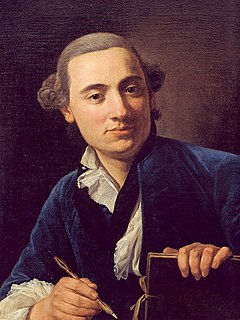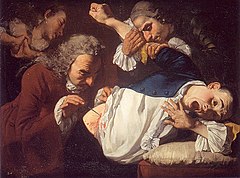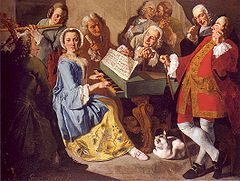Gaspare Traversi
Gaspare Traversi (* December 1722 or January / February 1723 in Naples , † November 1, 1770 in Trastevere , Rome ) was an artist from the school of Neapolitan Baroque painting . His long-forgotten oeuvre includes pictures with religious themes, portraits and numerous expressive works of genre painting .
Biographical data
The Traversis curriculum vitae is extremely sketchy. Some dates and events can be derived from image dating, others from church registers, invoices and the like. Contemporary authors almost completely omitted Traversi. Only Carlo Bianconi, an artist from Bologna , noted in a few lines in 1776, six years after Traversi's death, that Traversi had learned from the then famous painter Francesco Solimena in Naples and later went to Rome.
- Traversi's birth around the turn of the year 1722/23 can only be determined indirectly - from a much later, dated entry in a church document that also mentions his age of 45 at the time. His parents were Domenico and Margherita Traversi. Gaspare was the couple's first child, and as a result he had seven siblings and two half-sisters from his father's second marriage.
- In 1742 Fra Raffaello Rossi da Lugagnano was called to Naples, who later became Vicar General of the Franciscan Order , and Traversis longstanding patron.
- Traversi's signature with date on the painting in a Roman collection suggests that the painter was in Rome in 1748.
- In 1752 Traversi came to Rome, where he stayed until the end of his life. He lived in Trastevere , an old borough similar to that of his youth in Naples.
- In 1753 a series of images was created for the Franciscan convent near Piacenca, the old home of his patron, Fra Raffaello Rossi.
- Since 1755 Traversi has been listed repeatedly in the pastoral care register ( Liber Status Animarum ) of the Church of Santa Maria in the Trastevere district and referred to as a permanent resident of Rome.
- Traversi's sister Anna Maria Caterina came to Rome from Naples in 1756, they both ran a common household - temporarily even after Caterina's marriage in 1758.
- On February 13, 1759, Gaspare Traversi married Rosa Orlandi, two years his junior, in the Basilica of Santa Maria in Trastevere . After the wedding, they both moved to their in-laws' house nearby.
- Fra Raffaello Rossi died in 1760. Traversi's son, Giuseppe, was born on October 20 of the same year. The daughter Margherita was born on April 23, 1763. Two other sons, Raffaello and Innocenzo, died in 1766 and 1768 respectively in the year after their birth.
- In 1764 there was a severe famine throughout Italy (particularly Tuscany , the Papal States and Naples were affected). Apparently Traversi got fewer orders in the following years, so that he temporarily suffered from economic difficulties.
- In 1769, the painter took his widowed mother-in-law and her adult children into his household.
- Gaspare Traversi died on November 1, 1770 in his home in Trastevere ; according to the death register, he was buried three days later in the Basilica of Santa Maria.
Rediscovery
Soon after his death, Gaspare Traversi was almost completely forgotten and was not rediscovered until the 1920s by the Italian art historian Roberto Longhi . In three essays from 1927 for the magazine "Vita Artistica" Longhi developed the basis for research on the painter and for the attribution to his pictures. But even in the following decades until recently, Traversi was hardly represented in museums, exhibitions or in German-language research. That changed with the first solo exhibition prepared by the Staatsgalerie Stuttgart together with the Museo di Capodimonte in Naples and shown in 2003 first in Stuttgart, then in Traversi's birthplace.
Today around 200 works are attributed to Traversi, only 18 of them are signed, and only 10 of them are dated. The religious work comprises around 50 paintings, the profane pictures include around 50 portraits and 100 genre scenes. Other painters were usually accepted as the authors of his pictures: Giuseppe Bonito, Pier Leone Ghezzi and Corrado Giaquinto. The correction of these erroneous attributions began with Longhi's research after a collective exhibition of Italian painting in Florence in 1922 , in which Traversis pictures were hung, but his name was not mentioned.
The work
Influence of the Enlightenment
The relationship between Traversis and the ideas of the Enlightenment is assessed differently in the relevant research. It remains questionable whether the painter got to know individual representatives of this new view of the world in Naples - as a rule these were members of the educated, wealthy classes of the population - or whether his background from simple circumstances prevented this. In any case, Roberto Longhi ascertained an inner connection by judging, for example, of one of Traversi's pictures that it was like “commissioned by Diderot, painted by Chardin” , which on the one hand addressed Denis Diderot , one of the leading figures of the European Enlightenment, on the other hand Jean Siméon Chardin , a French painter of still lifes and genre paintings outside the academic painting of his time.
Traversi lived and worked in the transition area between baroque theatrics and the more sober gesture of the Enlightenment. He also applied his unpathetic , if haunting, perspective to traditional, highly dramatic pictorial subjects; in his portrayal of “ Salome ...”, as a reviewer of the Stuttgart exhibition described it, “presented [she] the head of the Baptist with such naive innocence as a recently picked head of lettuce”.
Portraits and Religious Subjects
Traversi had influential patrons in the Roman clergy . In addition to the Franciscan Fra Raffaello Rossi da Lugagnano, it was also members of other religious orders who procured him commissions, especially in the 1750s. This is how altar, devotional and religious history pictures were created. One of the main works from that period is a cycle of six large-format paintings for the Carmelite Church of San Crisogono in Trastevere, today kept elsewhere. The subjects dealt with in it, such as “The murder of Amnon at Absalom's banquet ”, are examples of drastic, figurative painting that differed from what was customary in Rome at the time. Traversi used an imagery that was more realistic, less idealized and thus reduced the distance to the viewer. For him, this part of his oeuvre was also significant because pictures with religious themes were traditionally particularly highly regarded (in accordance with the church-historical and dogmatic significance of the figures depicted) - although at that time a reassessment of the hierarchy of the pictorial genres began Portrait and genre painting was given greater importance.
Traversi was a sought-after portraitist. Several portraits of the Franciscan Raffaello Rossi and the Cardinal Gian Giacomo Millo come from his hand , for whose titular church San Crisogono he painted his six-part cycle. He also portrayed a number of other high-ranking clerics and other representatives of public life. Deviating from the prevailing practice of statuesque, representative portraits, he underlined the individuality of his models in his work.
Genre painting
Traversi grew up in an old, densely populated, particularly lively district of Naples. This is where the “Teatro di San Bartolomeo” had its seat, where Pergolesi's “ La Serva Padrona ” (“The Maid as Mistress”) was premiered in 1733 . This opera, originally conceived as a comic interlude for serious opera, is regarded as a model for a new, soon extremely popular form of musical theater, the “opera buffa”. In contrast to the “ Opera seria ” with its sublime themes, popular problems were now dealt with, everyday human behavior and weaknesses presented in a theatrical and comic form, the serious pathos of classic baroque opera occasionally caricatured in stories, “whose subversive cheerfulness reflects the pre-revolutionary spirit of the Enlightenment corresponded ".
In terms of content, Traversi followed this development in his genre pictures. With him, too, you can see the big gestures of the "little people" in everyday situations. Formally, he was influenced by the works of important baroque painters who had left their mark on Naples. He found his essential stylistic devices in the pictures of Michelangelo Merisi da Caravaggio , Jusepe de Ribera and Mattia Preti : expressive gestures, dramatic light, a naturalistic, sometimes even genre-like representation. The figurative solutions and the compositional principles that Traversi used in his religious representations also formed the basis of his profane scenes.
literature
- August Bernhard Rave: Gaspare Traversi. Joy in the shade . Catalog for the exhibition at the Staatsgalerie Stuttgart 2003. Hatje Cantz Verlag. ISBN 3-7757-1354-9 .
Web links
- Review of the Staatsgalerie Stuttgart on the Traversi exhibition 2003
- Review of the exhibition catalog “Gaspare Traversi”. (PDF file; 55 kB)
- Exhibition openings 12.7. until September 7, 2003: "Walter Bodmer 1903-1973. Painting, sculpture, drawing, relief"; Kunstmuseum Basel on "Die Zeit"
Individual evidence
- ^ August Bernhard Rave: Gaspare Traversi. Joy in the Shade, p. 147
- ^ August Bernhard Rave: Gaspare Traversi. Joy in the Shade, p. 153
- ↑ a b Concert pitch of the Enlightenment: Gaspare Traversi , by Stefan Tolksdorf, August 29, 2003, on welt.de, accessed February 23, 2009
- ^ August Bernhard Rave: Gaspare Traversi. Joy in the shade.
| personal data | |
|---|---|
| SURNAME | Traversi, Gaspare |
| SHORT DESCRIPTION | Italian baroque painter of the Neapolitan school |
| DATE OF BIRTH | around 1722 |
| PLACE OF BIRTH | Naples |
| DATE OF DEATH | November 1, 1770 |
| Place of death | Trastevere , Rome |







